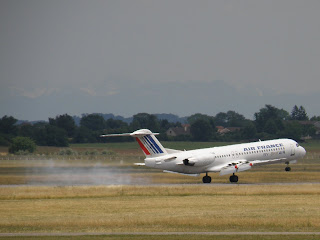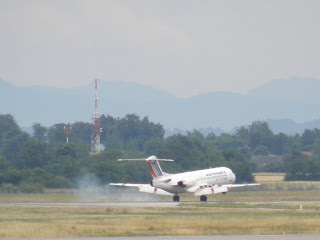

 Si nous avons vu précédemment comment un avion pouvait accélérer grâce à ces moteurs (voir http://my-airliner.blogspot.com/search/label/Moteur), nous n'avons pas vu comment ralentir...
Si nous avons vu précédemment comment un avion pouvait accélérer grâce à ces moteurs (voir http://my-airliner.blogspot.com/search/label/Moteur), nous n'avons pas vu comment ralentir...Comme n'importe quel véhicule automobile, les avions sont équipés de freins sur les roues. Mais vu les vitesses et la masse de la machine, ils ne sont guère utiles dans le freinage, et servent plus à stopper l'avion à faible vitesse ou le faire tourner une fois au sol qu'à vraiment freiner l'appareil lorsqu'il est à pleine vitesse.
Mais alors qu'est ce qui freine les avions?
Tout d'abord, les volets. J'en parle dans l'article http://my-airliner.blogspot.com/2009/04/comment-diriger-un-avion-le-moyen-de.html. Ils permettent de réduire un peu la vitesse en augmentant la trainée de l'appareil. Toutefois, en condition normale de vol, ils ne sont pas utilisés comme système de freinage.
Les roues arrières d'un ATR42.
 Les trains d'atterrissage peuvent être rangés dans la même catégorie. Leurs sortie génère une forte trainée qui provoque un freinage important de l'avion.
Les trains d'atterrissage peuvent être rangés dans la même catégorie. Leurs sortie génère une forte trainée qui provoque un freinage important de l'avion.Ensuite, les aérofreins. Ce sont des volets mobiles (A) qui se soulèvent sur le dessus de l'aile. Outre la résistance à l'air qu'ils créent, ils sont dit hypo-sustentateurs car ils cassent l'effet de portance de l'aile.
 Les avions équipes de turbopropulseur n'en son pas équipés. C'est la mise en rideau de l'hélice qui assure le rôle d'aérofrein.
Les avions équipes de turbopropulseur n'en son pas équipés. C'est la mise en rideau de l'hélice qui assure le rôle d'aérofrein.Enfin, la principale source de freinage, c'est le moteur. Sur les turbo réacteur, la poussée du moteur est inversée par des flaps (B), ce qui fournis le gros de la décélération en déviant le flux (A). Dans le cas d'un avion à hélice, cette dernière est mise en rideau, avec les mêmes effets que l'inversion de poussée des turboréacteur.

 Un bon exemple en est donné sur mes photos: regardez le Fokker 100 ci dessous qui déploie ces volets, ces aerofreins et ces inverseurs de poussée...
Un bon exemple en est donné sur mes photos: regardez le Fokker 100 ci dessous qui déploie ces volets, ces aerofreins et ces inverseurs de poussée...
 Mauette des freins arrières Carbone/carbone d'Airbus A330/A340.
Mauette des freins arrières Carbone/carbone d'Airbus A330/A340.
 If we see before how airplanes can accelerate by using its engine (see http://my-airliner.blogspot.com/search/label/Moteur), we didn't see how to lost speed...
If we see before how airplanes can accelerate by using its engine (see http://my-airliner.blogspot.com/search/label/Moteur), we didn't see how to lost speed...Like each automobile vehicles, the airplanes are equiped with brakes on the wheels According the speed and the weight of these devices, it can't decelerate sufficiently the airplane. In fact, it's used to drive the plane on the ground, and to stop it at low speed.
So, how to brake the planes?
In first, the flaps. I speak about it in the article http://my-airliner.blogspot.com/2009/04/comment-diriger-un-avion-le-moyen-de.html. It permite to decrease a little bit the fast by increase the aerodynamic loose. But in normals flight conditions, it is not used to brake.
The wheals gear can be set in the same category. The exit of the wheels cause a strong aerodynamic loose, that do a strong braking of the plane.
Rear wheels of an ATR 42.

Then, the airbrake. It is mobils flaps (A) who lift them on the top of the wing. It resist to the air flow, and breake the aerodynamic lift.  Propler engined airplanes are not equiped with this device. The braking force is obtened by the propler position change.
Propler engined airplanes are not equiped with this device. The braking force is obtened by the propler position change.
At least, the most important braking source is the engine. On the turbojet engine, the air flow is inversed by flaps (B), what is furnish the most important braking force by moving the air flow (A). In the case of a propler airplane, the propler is turned in brake position, with the same effect of the inversed air flow on turbojet engine.

 A good example is gift on my pictures: look at the Fokker 100 just under who use its flaps, airbrakes, and engine inversor...
A good example is gift on my pictures: look at the Fokker 100 just under who use its flaps, airbrakes, and engine inversor...

 Propler engined airplanes are not equiped with this device. The braking force is obtened by the propler position change.
Propler engined airplanes are not equiped with this device. The braking force is obtened by the propler position change.At least, the most important braking source is the engine. On the turbojet engine, the air flow is inversed by flaps (B), what is furnish the most important braking force by moving the air flow (A). In the case of a propler airplane, the propler is turned in brake position, with the same effect of the inversed air flow on turbojet engine.

 A good example is gift on my pictures: look at the Fokker 100 just under who use its flaps, airbrakes, and engine inversor...
A good example is gift on my pictures: look at the Fokker 100 just under who use its flaps, airbrakes, and engine inversor...







11 commentaires:
Thank you, that was extremely valuable and interesting...I will be back again to read more on this topic.
Fantastic blog, I hadn't noticed my-airliner.blogspot.com previously during my searches!
Continue the superb work!
Thanks for sharing this link, but unfortunately it seems to be down... Does anybody have a mirror or another source? Please answer to my post if you do!
I would appreciate if a staff member here at my-airliner.blogspot.com could post it.
Thanks,
Thomas
I'm sorry, but I'm not sure to understand tour remarks, because all these link are working well in my home...
Maybe try to copy and paste the adress in your internet browser?
Good luck, and thank you very much for reading!
Greetings,
I have a question for the webmaster/admin here at www.blogger.com.
May I use some of the information from your post right above if I provide a link back to your site?
Thanks,
Mark
Hi there,
I have a question for the webmaster/admin here at my-airliner.blogspot.com.
May I use part of the information from your post above if I provide a backlink back to this website?
Thanks,
Mark
Greetings,
This is a question for the webmaster/admin here at my-airliner.blogspot.com.
Can I use part of the information from your post above if I give a link back to your website?
Thanks,
Jack
Awesome post. Do you mind if I ask what your source is for this information?
Hi there,
This is a message for the webmaster/admin here at my-airliner.blogspot.com.
Can I use part of the information from this blog post above if I give a backlink back to your website?
Thanks,
John
Hey,
This is a message for the webmaster/admin here at my-airliner.blogspot.com.
May I use some of the information from your post above if I provide a backlink back to your website?
Thanks,
James
Hi - I am definitely happy to find this. great job!
Enregistrer un commentaire